11.4 Social Relations
We have sampled how we think about and influence one another. Now we come to social psychology’s third focus—
Prejudice
LOQ 11-
prejudice an unfair and usually negative attitude toward a group and its members. Prejudice generally involves stereotyped beliefs, negative feelings, and a predisposition to discriminatory action.
Prejudice means “prejudgment.” It is an unfair negative attitude toward some group. The target of the prejudice is often a different cultural, ethnic, or gender group.
Prejudice is a three-
stereotype a generalized (sometimes accurate but often overgeneralized) belief about a group of people.
beliefs (called stereotypes).
emotions (for example, hostility, envy, or fear).
predispositions to action (to discriminate).
“Unhappily the world has yet to learn how to live with diversity.”
Pope John Paul II, Address to the United Nations, 1995
discrimination unjustifiable negative behavior toward a group and its members.
Some stereotypes may be at least partly accurate. If you presume that obese individuals usually have more health issues than healthy-
Our ideas influence what we notice and how we interpret events. In one classic 1970s study, most White participants who saw a White man shoving a Black man said they were “horsing around.” When they saw a Black man shoving a White man, they interpreted the same act as “violent” (Duncan, 1976). The ideas we bring to a situation can color our perceptions.

How Prejudiced Are People?
Again and again throughout this book, we have seen that the human mind processes thoughts, memories, and attitudes on two different tracks. Sometimes that processing is explicit—
EXPLICIT ETHNIC PREJUDICE To assess prejudice, we can observe what people say and what they do. Americans’ expressed racial attitudes have changed dramatically in the last half-
Yet as open prejudice wanes, subtle prejudice lingers. Despite increased verbal support for interracial marriage, many people admit that in socially intimate settings (dating, dancing, marrying) they would feel uncomfortable with someone of another race. Subtle prejudice may also take the form of “microaggressions,” such as race-
IMPLICIT ETHNIC PREJUDICE Prejudice can be not only subtle but also implicit, an automatic attitude that is more of an unthinking knee-
Implicit racial associations Even people who deny harboring racial prejudice may carry negative associations (Fisher & Borgida, 2012; Greenwald et al., 1998, 2015). For example, 9 in 10 White respondents took longer to identify pleasant words (such as peace and paradise) as “good” when the words were paired with Black-
Race-
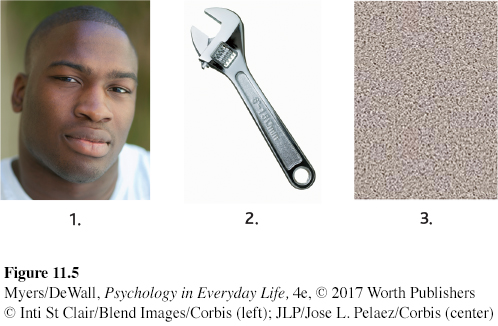
In a 2015 housing discrimination case, the U.S. Supreme Court recognized implicit bias research. They noted that “unconscious prejudices” can cause discrimination even when people do not consciously intend to discriminate. Are you sometimes aware that you have feelings you would rather not have about other people? If so, remember this: It is what we do with our feelings that matters. By monitoring our feelings and actions, and by replacing old habits with new ones based on new friendships, we can free ourselves of prejudice.
GENDER PREJUDICE Gender prejudice and discrimination persist, too. Despite gender equality in intelligence scores, people have tended to perceive their fathers as more intelligent than their mothers (Furnham & Wu, 2008). We pay more to those (usually men) who care for our streets than to those (usually women) who care for our children. Worldwide, women have been more likely to live in poverty (Lipps, 1999). And among adults who cannot read, two-
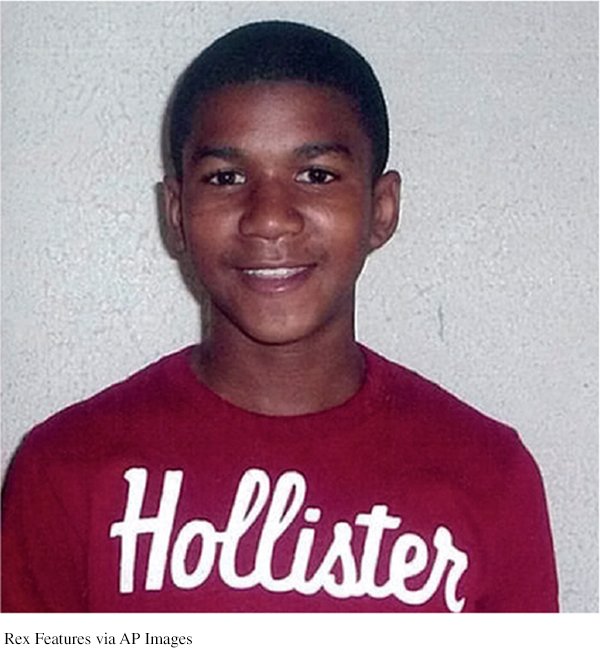
Unwanted female infants are no longer left on a hillside to die of exposure, as was the practice in ancient Greece. Yet the normal male-
SEXUAL ORIENTATION PREJUDICE In many places in the world, gays and lesbians cannot comfortably acknowledge who they are and whom they love (Katz-
Social Roots of Prejudice
LOQ 11-
Why does prejudice arise? Social inequalities and social divisions are partly responsible.
just-
SOCIAL INEQUALITIES Some people have money, power, and prestige. Others do not. In this situation, the “haves” usually develop attitudes that justify things as they are. The just-
Victims of discrimination may react in ways that feed prejudice through the classic blame-
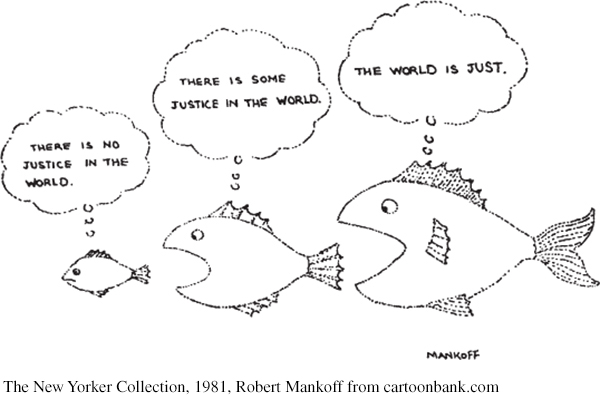
US AND THEM: INGROUP AND OUTGROUP We have inherited our Stone Age ancestors’ need to belong—
ingroup “us”—people with whom we share a common identity.
outgroup “them”—those perceived as different or apart from our group.
ingroup bias the tendency to favor our own group.
Evolution prepared us, when meeting strangers, to make instant judgments: friend or foe? Those from our group, those who look like us, and also those who sound like us—
“All good people agree,
And all good people say
All nice people, like Us, are We
And everyone else is They.”
Rudyard Kipling, “We and They,” 1926
Ingroup bias explains why active supporters of political parties may see what they expect to see (Cooper, 2010; Douthat, 2010). In the United States in the late 1980s, most Democrats believed inflation had risen under Republican president Ronald Reagan. (They were wrong: It had dropped.) In 2010, most Republicans believed that taxes had increased under Democratic president Barack Obama. (They were wrong: For most people, they had decreased.)
Emotional Roots of Prejudice
scapegoat theory the theory that prejudice offers an outlet for anger by providing someone to blame.
Prejudice springs not only from the divisions of society but also from the passions of the heart. Scapegoat theory proposes that when things go wrong, finding someone to blame can provide an outlet for anger. Following the 9/11 terrorist attacks, negative stereotypes blossomed. Some outraged people lashed out at innocent Arab-
Evidence for the scapegoat theory of prejudice comes from two sources:
Prejudice levels tend to be high among economically frustrated people.
In experiments, a temporary frustration increases prejudice. Students made to feel temporarily insecure have often restored their self-
esteem by speaking badly of a rival school or another person (Cialdini & Richardson, 1980; Crocker et al., 1987). Those made to feel loved and supported have become more open to and accepting of others who differ (Mikulincer & Shaver, 2001).
Negative emotions nourish prejudice. When facing death, fearing threats, or experiencing frustration, we cling more tightly to our ingroup and our friends. The terror of death heightens patriotism. It also produces anger and aggression toward “them”—those who threaten our world (Pyszczynski et al., 2002, 2008).
Cognitive Roots of Prejudice
LOQ 11-
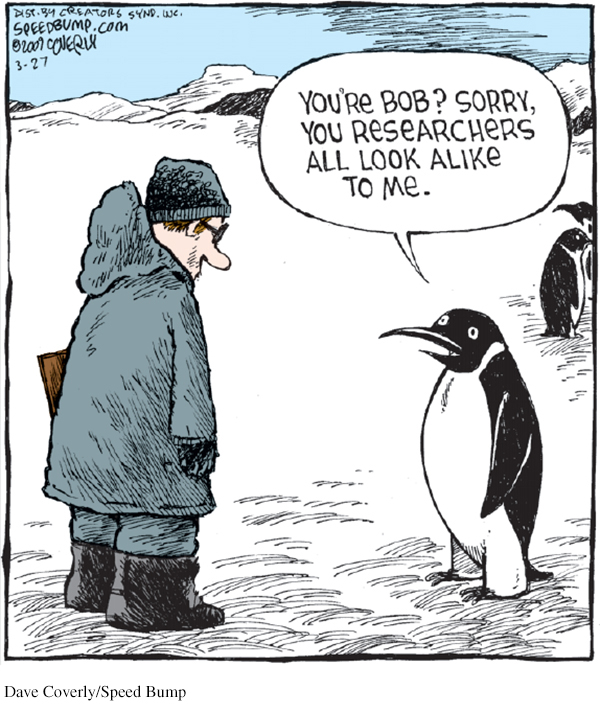
Prejudice springs from a culture’s divisions, the heart’s passions, and also from the mind’s natural workings. Stereotyped beliefs are a by-
FORMING CATEGORIES One way we simplify our world is to sort things into categories. A chemist sorts molecules into categories of “organic” and “inorganic.” Therapists categorize psychological disorders. All of us categorize people by race, with mixed-

other-

When we categorize people into groups, we often overestimate their similarities. “They”—the members of that other social or ethnic group—
REMEMBERING VIVID CASES Cognitive psychologists tell us that we often judge the likelihood of events by recalling vivid cases that readily come to mind. In a classic experiment, researchers showed two groups of student volunteers lists containing information about 50 men (Rothbart et al., 1978). The first group’s list included 10 men arrested for nonviolent crimes, such as forgery. The second group’s list included 10 men arrested for violent crimes, such as assault. Later, both groups were asked how many men on their list had committed any sort of crime. The second group overestimated the number. Vivid—
BELIEVING THE WORLD IS JUST As noted earlier, people often justify their prejudices by blaming the victims. If the world is just, they assume, people must get what they deserve. As one German civilian is said to have remarked when visiting the Bergen-
 To review attribution research and experience a simulation of how stereotypes form, visit LaunchPad’s PsychSim 6: Not My Type. And for a 6.5-
To review attribution research and experience a simulation of how stereotypes form, visit LaunchPad’s PsychSim 6: Not My Type. And for a 6.5-
People have a basic tendency to justify their culture’s social systems (Jost et al., 2009; Kay et al., 2009). We’re inclined to see the way things are as the way they ought to be. This natural conservatism makes it difficult to legislate major social changes, such as civil rights laws or Social Security or health care reform. But once such policies are in place, our “system justification” tends to preserve them.
Retrieve + Remember
Question 11.12
•When a prejudiced attitude causes us to blame an innocent person for our problems, we have used that person as a _________.
ANSWER: scapegoat
Aggression
aggression any act intended to harm someone physically or emotionally.
The most destructive force in our social relations is aggression. In psychology, aggression is any verbal or physical behavior intended to harm someone, whether it is passing along a vicious rumor or engaging in a physical attack.
Aggressive behavior emerges when biology interacts with experience. For a gun to fire, the trigger must be pulled. With some people, as with hair-
The Biology of Aggression
LOQ 11-
Is aggression an unlearned instinct? The wide variation from culture to culture, era to era, and person to person argues against that idea. But biology does influence aggression at three levels—

GENETIC INFLUENCES Genes influence aggression. We know this because animals have been bred for aggressiveness—
 See LaunchPad’s Video: Twin Studies for a helpful tutorial animation.
See LaunchPad’s Video: Twin Studies for a helpful tutorial animation.
BIOCHEMICAL INFLUENCES Our genes engineer our individual nervous systems, which operate electrochemically. The hormone testosterone, for example, circulates in the bloodstream and influences the neural systems that control aggression. A raging bull becomes a gentle giant when castration reduces its testosterone level. And when injected with testosterone, gentle, castrated mice once again become aggressive.
In humans, high testosterone is associated with irritability, assertiveness, impulsiveness, and low tolerance for frustration. These qualities make people somewhat more prone to aggressive responses when provoked or when competing for status (Dabbs et al., 2001; McAndrew, 2009; Montoya et al., 2012). Among both teenage boys and adult men, high testosterone levels have been linked with delinquency, hard drug use, and aggressive-

Another drug that sometimes circulates in the bloodstream—
NEURAL INFLUENCES There is no one spot in the brain that controls aggression. Aggression is a complex behavior, and it occurs in particular contexts. But animal and human brains have neural systems that, given provocation, will either inhibit or facilitate aggression (Dambacher et al., 2015; Denson, 2011; Moyer, 1983). Consider:
Researchers implanted a radio-
controlled electrode in the brain of the domineering leader of a caged monkey colony. The electrode was in an area that, when stimulated, inhibits aggression. When researchers placed the control button for the electrode in the colony’s cage, one small monkey learned to push it every time the boss became threatening. A neurosurgeon implanted an electrode in the brain of a mild-
mannered woman to diagnose a disorder. The electrode was in her amygdala, within her limbic system. Because the brain has no sensory receptors, she did not feel the stimulation. But at the flick of a switch, she snarled, “Take my blood pressure. Take it now,” then stood up and began to strike the doctor. Studies of violent criminals have revealed diminished activity in the frontal lobes, which help control impulses. If the frontal lobes are damaged, inactive, disconnected, or not yet fully mature, aggression may be more likely (Amen et al., 1996; Davidson et al., 2000; Raine, 2013).
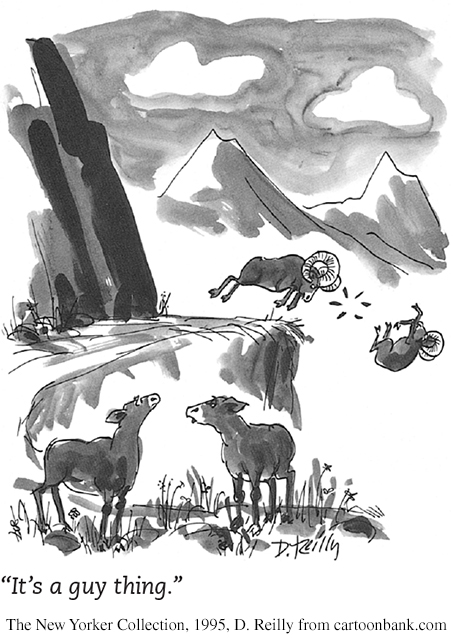
Psychological and Social-Cultural Influences on Aggression
LOQ 11-
Biological factors influence how easily aggression is triggered. But what psychological and social-
frustration-
AVERSIVE EVENTS Suffering sometimes builds character. In laboratory experiments, however, those made miserable have often made others miserable (Berkowitz, 1983, 1989). This reaction is called the frustration-
they had been frustrated by the previous batter hitting a home run.
the current batter hit a home run the last time at bat.
a teammate of the pitcher had been hit by a pitch in the previous half-
inning.
Other aversive stimuli—

 How have researchers studied these concepts? Learn more at LaunchPad’s Immersive Learning: How Would You Know If Hot Temperatures Cause Aggression?
How have researchers studied these concepts? Learn more at LaunchPad’s Immersive Learning: How Would You Know If Hot Temperatures Cause Aggression?
REINFORCEMENT AND MODELING Aggression may naturally follow aversive events, but learning can alter natural reactions. As Chapter 6 points out, we learn when our behavior is reinforced, and we learn by watching others. Children whose aggression successfully intimidates other children may become bullies. Animals that have successfully fought to get food or mates become increasingly ferocious. To foster a kinder, gentler world, we had best model and reward sensitivity and cooperation from an early age, perhaps by training parents to discipline without modeling violence.
Parent-
“Why do we kill people who kill people to show that killing people is wrong?”
National Coalition to Abolish the Death Penalty, 1992
Different cultures model, reinforce, and evoke different tendencies toward violence. Some cultures encourage people to fight to defend their honor (Nowak et al., 2016). Crime rates have also been higher (and happiness lower) in times and places marked by a great income gap between rich and poor (Messias et al., 2011; Oishi et al., 2011; Wilkinson & Pickett, 2009). And high rates of violence and youth imprisonment have been found in cultures and families with minimal or no father care (Harper & McLanahan, 2004; Triandis, 1994).
social script a culturally modeled guide for how to act in various situations.
MEDIA MODELS FOR VIOLENCE Parents are not the only aggression models. In the United States and elsewhere, TV shows, films, video games, and the Internet offer supersized portions of violence. Repeatedly viewing on-
Music lyrics also write social scripts. In experiments, German university men who listened to woman-
Sexual scripts in pornographic films can also be toxic. Repeatedly watching pornography makes sexual aggression seem less serious (Harris, 1994). In one experiment, undergraduates viewed six brief, sexually explicit films each week for six weeks (Zillmann & Bryant, 1984). A control group viewed films with no sexual content during the same six-
While nonviolent sexual content affects aggression-
To a lesser extent, nonviolent pornography can also influence aggression. One set of studies explored pornography’s effects on aggression toward relationship partners. The result? Pornography consumption predicted both self-
DO VIOLENT VIDEO GAMES TEACH SOCIAL SCRIPTS FOR VIOLENCE? Experiments in North America, Western Europe, Singapore, and Japan indicate that playing positive games produces positive effects (Greitemeyer & Osswald, 2010, 2011; Prot et al., 2014). For example, playing Lemmings, where a goal is to help others, increases real-
In 2002, three young men in Michigan spent part of a night drinking beer and playing Grand Theft Auto III. Using simulated cars, they ran down pedestrians, then beat them with fists, leaving a bloody body behind (Kolker, 2002). These young men then went out for a real drive. Spotting a 38-
Such violent mimicry causes some to wonder: What are the effects of actively role-

Ah, but is this merely because naturally hostile kids are drawn to such games? Apparently not. Comparisons of gamers and nongamers who scored low on hostility measures revealed a difference in the number of fights reported. Almost 4 in 10 violent-
Other researchers are unimpressed by such findings (Ferguson, 2014, 2015). They note that from 1996 to 2006, youth violence declined while video game sales increased. They argue that other factors—
* * *
To sum up, research reveals biological, psychological, and social-
A happy concluding note: Historical trends suggest that the world is becoming less violent over time (Pinker, 2011). That people vary over time and place reminds us that environments differ. Yesterday’s plundering Vikings have become today’s peace-
Retrieve + Remember
Question 11.13
•What psychological, biological, and social-
ANSWER: Our biology (our genes, biochemistry, and neural systems—
Attraction
Pause a moment and think about your relationships with two people—
The Psychology of Attraction
LOQ 11-
We endlessly wonder how we can win others’ affection and what makes our own affections flourish or fade. Does familiarity breed contempt or affection? Do birds of a feather flock together, or do opposites attract? Is it what’s inside that counts, or does physical attractiveness matter greatly? To explore these questions, let’s consider three ingredients of our liking for one another: proximity, physical attractiveness, and similarity.
PROXIMITY Before friendships become close, they must begin. Proximity—

mere exposure effect the phenomenon that repeated exposure to novel stimuli increases liking of them.
Proximity breeds liking partly because of the mere exposure effect. Repeated exposure to novel stimuli increases our liking for them. By age three months, infants prefer photos of the race they most often see—
So, within certain limits, familiarity feeds fondness (Bornstein, 1989, 1999; Finkel et al., 2015b). Researchers demonstrated this by having four equally attractive women silently attend a 200-

MODERN MATCHMAKING If you have not found a romantic partner in your immediate proximity, why not cast a wider net? Each year, an estimated 30 million people search for love on one of the 1500 online dating sites (Ellin, 2009). Online matchmaking seems to work mostly by expanding the pool of potential mates (Finkel et al., 2012a, b).
How effective are Internet matchmaking services? Compared with those formed in person, Internet-
Dating sites collect trait information, but that accounts for only a thin slice of what makes for successful long-
Speed dating pushes the search for romance into high gear. In a process pioneered by a matchmaking Jewish rabbi, people meet a succession of would-
Researchers have quickly realized that speed dating offers a unique opportunity for studying influences on our first impressions of potential romantic partners. Among recent findings are these:
People who fear rejection often provoke rejection. After a 3-
minute speed date, those who most feared rejection were least often selected for a follow- up date (McClure & Lydon, 2014). Given more options, people make more superficial choices. They focus on more easily assessed characteristics, such as height and weight (Lenton & Francesconi, 2010, 2012). This was true even when researchers controlled for time spent with each partner.
Men wish for future contact with more of their speed dates; women tend to be choosier. This gender difference disappears if the conventional roles are reversed, so that men stay seated while women circulate (Finkel & Eastwick, 2009).


PHYSICAL ATTRACTIVENESS So proximity offers contact. What most affects our first impressions? The person’s sincerity? Intelligence? Personality? The answer is physical appearance. This finding is unnerving for those of us taught that “beauty is only skin deep” and “appearances can be deceiving.”
In one early study, researchers randomly matched new students for a Welcome Week dance (Walster et al., 1966). Before the dance, the researchers gave each student a battery of personality and aptitude tests, and they rated each student’s physical attractiveness. During the blind date, the couples danced and talked for more than two hours and then took a brief break to rate their dates. What determined whether they liked each other? Only one thing seemed to matter: appearance. Both the men and the women liked good-
Physical attractiveness also predicts how often people date and how popular they feel. We perceive attractive people as healthier, happier, more sensitive, more successful, and more socially skilled (Eagly et al., 1991; Feingold, 1992; Hatfield & Sprecher, 1986). Attractive, well-
For those of us who find the importance of looks unfair and short-
First, people’s attractiveness seems surprisingly unrelated to their self-
esteem and happiness (Diener et al., 1995; Major et al., 1984). Unless we have just compared ourselves with superattractive people, few of us (thanks, perhaps, to the mere exposure effect) view ourselves as unattractive (Thornton & Moore, 1993). Second, strikingly attractive people are sometimes suspicious that praise for their work is simply a reaction to their looks. Less attractive people have been more likely to accept praise as sincere (Berscheid, 1981).
Page 337Third, for couples who were friends before lovers—
who became romantically involved long after first meeting— looks were less important (Hunt et al., 2015). With slow- cooked love, looks mattered less and common interests mattered more.
Percentage of Men and Women Who “Constantly Think About Their Looks”
| Men | Women | |
| Canada | 18% | 20% |
| United States | 17 | 27 |
| Mexico | 40 | 45 |
| Venezuela | 47 | 65 |
From Roper Starch survey, reported by McCool (1999).
Beauty is also in the eye of the culture. Hoping to look attractive, people across the globe have pierced and tattooed their bodies, lengthened their necks, bound their feet, and artificially lightened or darkened their skin and hair. Cultural ideals also change over time. In the United States, the soft, voluptuous Marilyn Monroe ideal of the 1950s has been replaced by today’s lean yet busty ideal.
Do any aspects of heterosexual attractiveness cross place and time? Yes. As we noted in Chapter 4, men in many cultures, from Australia to Zambia, judge women as more attractive if they have a youthful, fertile appearance, suggested by a low waist-
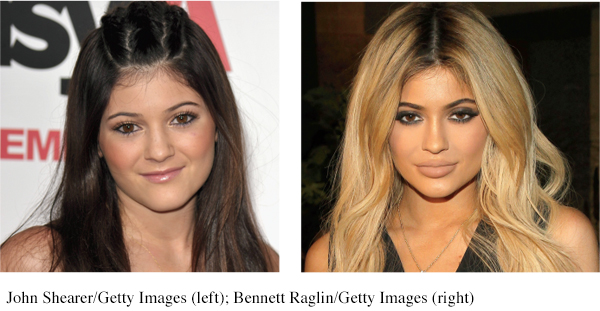
Our feelings also influence our attractiveness judgments. Imagine two people: One is honest, humorous, and polite. The other is rude, unfair, and abusive. Which one is more attractive? Most people perceive the person with the appealing traits as more attractive (Lewandowski et al., 2007). Or imagine being paired with an opposite-
In a Rodgers and Hammerstein musical, Prince Charming asks Cinderella, “Do I love you because you’re beautiful, or are you beautiful because I love you?” Chances are it’s both. As we see our loved ones again and again, we notice their physical imperfections less, and their attractiveness grows more obvious (Beaman & Klentz, 1983; Gross & Crofton, 1977). Shakespeare said it in A Midsummer Night’s Dream: “Love looks not with the eyes, but with the mind.” Come to love someone and watch beauty grow.
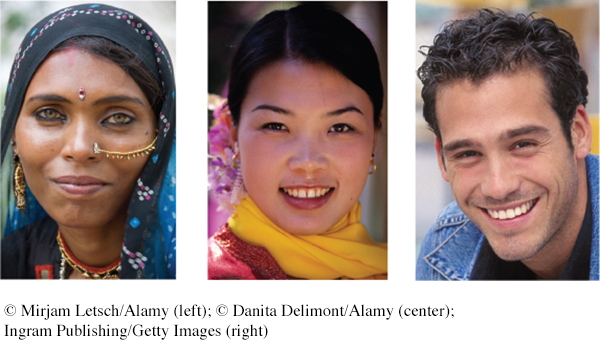
SIMILARITY So you’ve met someone, and your appearance has made a decent first impression. What influences whether you will become friends? As you get to know each other, will the chemistry be better if you are opposites or if you are alike?
It makes a good story—
Proximity, attractiveness, and similarity are not the only forces that influence attraction. We also like those who like us. This is especially true when our self-
Indeed, all the findings we have considered so far can be explained by a simple reward theory of attraction. We will like those whose behavior is rewarding to us, including those who are both able and willing to help us achieve our goals (Montoya & Horton, 2014). When people live or work in close proximity, it requires less time and effort to develop the friendship and enjoy its benefits. When people are attractive, they are aesthetically pleasing, and associating with them can be socially rewarding. When people share our views, they reward us by confirming our beliefs.
Retrieve + Remember
Question 11.14
•People tend to marry someone who lives or works nearby. This is an example of proximity and the ________ _______ _______ in action.
ANSWER: mere exposure effect
Question 11.15
•How does being physically attractive influence others’ perceptions?
ANSWER: Being physically attractive tends to elicit positive first impressions. People tend to assume that attractive people are healthier, happier, and more socially skilled than others are.
Romantic Love
LOQ 11-
Sometimes people move from first impressions, to friendship, to the more intense, complex, and mysterious state of romantic love. Passionate love mixes something new with something positive (Aron et al., 2000; Coulter & Malouff, 2013). We intensely desire to be with our partner (Hatfield et al., 2015). When we see our partner, blood flows to a brain region linked to craving and obsession (Acevedo et al., 2012). But the intoxication of passionate love is often temporary. If love endures, passionate love will mellow into a lingering companionate love (Hatfield, 1988).
passionate love an aroused state of intense positive absorption in another, usually present at the beginning of romantic love.
PASSIONATE LOVE A key ingredient of passionate love is arousal. The two-
Emotions have two ingredients—
physical arousal and cognitive appraisal. Arousal from any source can enhance an emotion, depending on how we interpret and label the arousal.
In one famous experiment, researchers studied people crossing two bridges above British Columbia’s rocky Capilano River (Dutton & Aron, 1974, 1989). One, a swaying footbridge, was 230 feet above the rocks. The other was low and solid. The researchers had an attractive young woman stop men coming off each bridge and ask their help in filling out a short questionnaire. She then offered her phone number in case they wanted to hear more about her project. Which men accepted the number and later called the woman? Far more of those who had just crossed the high bridge—
“When two people are under the influence of the most violent, most insane, most delusive, and most transient of passions, they are required to swear that they will remain in that excited, abnormal, and exhausting condition continuously until death do them part.”
George Bernard Shaw, Getting Married, 1908
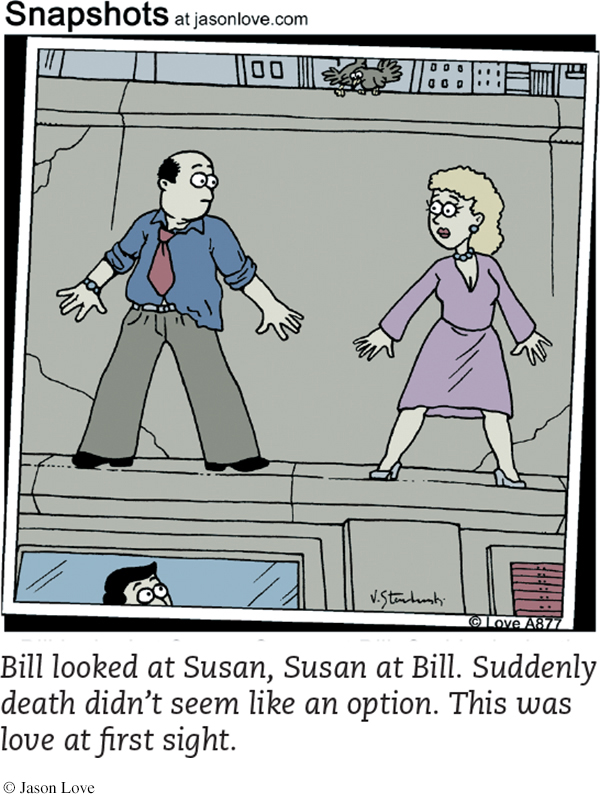
companionate love the deep affectionate attachment we feel for those with whom our lives are intertwined.
COMPANIONATE LOVE Passionate romantic love seldom endures. The intense absorption in the other, the thrill of the romance, the giddy “floating on a cloud” feeling typically fade. Are the French correct in saying that “love makes the time pass and time makes love pass”? As love matures, it typically becomes a steadier companionate love—
There may be adaptive wisdom to this shift from passion to attachment (Reis & Aron, 2008). Passionate love often produces children, whose survival is aided by the parents’ waning obsession with each other. Failure to appreciate passionate love’s limited half-
equity a condition in which people receive from a relationship in proportion to what they give to it.
One key to a satisfying and enduring relationship is equity, as both partners receive in proportion to what they give (Gray-
Equity’s importance extends beyond marriage. Mutually sharing one’s self and possessions, making decisions together, giving and getting emotional support, promoting and caring about each other’s welfare—
self-
Another vital ingredient of loving relationships is self-


One study marched pairs of students through 45 minutes of increasingly self-
In the mathematics of love, self-
Retrieve + Remember
Question 11.16
•How does the two-
ANSWER: Emotions consist of (1) physical arousal and (2) our interpretation of that arousal. Researchers have found that any source of arousal will be interpreted as passion in the presence of a desirable person.
Question 11.17
•Two vital components for maintaining companionate love are _________and ______-_______.
ANSWERS: equity; self-
Altruism
LOQ 11-
altruism unselfish concern for the welfare of others.
Altruism is an unselfish concern for the welfare of others, such as Dirk Willems displayed when he rescued his jailer. Heroes are moral, courageous, and protective of those in need (Kinsella et al., 2015). Consider the heroic example of altruism that took place in a New York City subway station. Construction worker Wesley Autrey and his 6-
Such selfless goodness made New Yorkers proud to call that city home. Another New York story, four decades earlier, had a different ending. In 1964, a stalker repeatedly stabbed Kitty Genovese, then raped her as she lay dying outside her Queens, New York, apartment at 3:30 A.M. “Oh, my God, he stabbed me!” Genovese screamed into the early morning stillness. “Please help me!” Windows opened and lights went on as some neighbors heard her screams. Her attacker fled. Then he returned to stab and rape her again. Not until he had fled for good did anyone so much as call the police, at 3:50 A.M.
Bystander Intervention
In an emergency, some people intervene, as Wesley Autrey did, but others fail to offer help. Why do some people become heroes while others just stand and watch? Social psychologists John Darley and Bibb Latané (1968b) believed three conditions were necessary for bystanders to help (FIGURE 11.9). They must
notice the incident.
interpret the event as an emergency.
assume responsibility for helping.
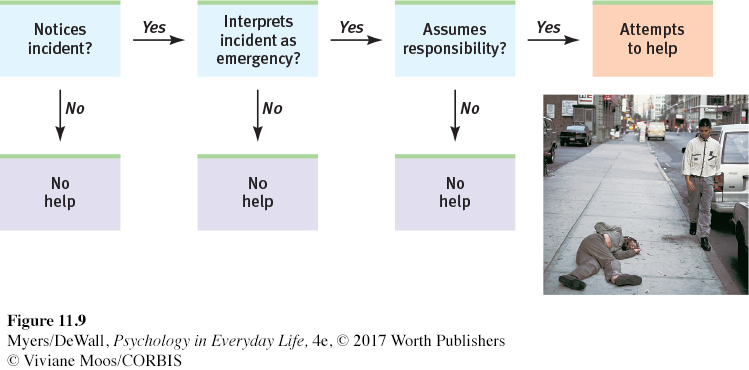
At each step, the presence of others can turn people away from the path that leads to helping. Darley and Latané (1968a) reached these conclusions after interpreting the results of a series of experiments. For example, they staged a fake emergency as students in separate laboratory rooms took turns speaking over an intercom. Only the person whose microphone was switched on could be heard. When his turn came, one student (who was actually working for the experimenters) pretended to have an epileptic seizure, and he called for help.
How did the others react? As FIGURE 11.10 shows, those who believed only they could hear the victim—
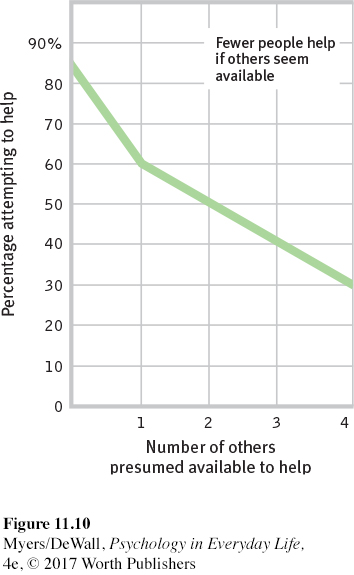
 For a review of research on emergency helping, visit LaunchPad’s Concept Practice: When Will People Help Others?
For a review of research on emergency helping, visit LaunchPad’s Concept Practice: When Will People Help Others?
bystander effect the tendency for any given bystander to be less likely to give aid if other bystanders are present.
Hundreds of additional experiments have confirmed this bystander effect. For example, researchers and their assistants took 1497 elevator rides in three cities and “accidentally” dropped coins or pencils in front of 4813 fellow passengers (Latané & Dabbs, 1975). When alone with the person in need, 40 percent helped; in the presence of five other bystanders, only 20 percent helped.
Observations of behavior in thousands of situations—
the person appears to need and deserve help.
the person is in some way similar to us.
the person is a woman.
we have just observed someone else being helpful.
we are not in a hurry.
we are in a small town or rural area.
we are feeling guilty.
we are focused on others and not preoccupied.
we are in a good mood.
This last result, that happy people are helpful people, is one of the most consistent findings in all of psychology. As poet Robert Browning (1868) observed, “Oh, make us happy and you make us good!” It doesn’t matter how we are cheered. Whether by being made to feel successful and intelligent, by thinking happy thoughts, by finding money, or even by receiving a posthypnotic suggestion, we become more generous and more eager to help (Carlson et al., 1988).
So happiness breeds helpfulness. But it’s also true that helpfulness breeds happiness. Helping those in need activates brain areas associated with reward (Harbaugh et al., 2007; Kawamichi et al., 2015). That helps explain a curious finding: People who give money away are happier than those who spend it almost entirely on themselves. In one experiment, researchers gave people an envelope with cash and instructions. Some were told to spend it on themselves, while others were told to spend it on others (Dunn et al., 2008; Dunn & Norton, 2013). Which group was happiest at the day’s end? It was, indeed, those assigned to the spend-
Retrieve + Remember
Question 11.18
•Why didn’t anybody help Kitty Genovese? What social relations principle did this incident illustrate?
ANSWER: In the presence of others, an individual is less likely to notice a situation, correctly interpret it as an emergency, and then take responsibility for offering help. The Kitty Genovese case demonstrated this bystander effect, as each witness assumed many others were also aware of the event.
The Norms for Helping
LOQ 11-
reciprocity norm an expectation that people will help, not hurt, those who have helped them.
Why do we help? Sometimes we go to the aid of another because we have been socialized to do so, through norms that prescribe how we ought to behave (Everett et al., 2015). Through socialization, we learn the reciprocity norm: the expectation that we should return help, not harm, to those who have helped us. In our relations with others of similar status, the reciprocity norm compels us to give (in favors, gifts, or social invitations) about as much as we receive. People who are generously treated become more likely to be generous to a stranger—
The reciprocity norm kicked in after Dave Tally, a Tempe, Arizona homeless man, found $3300 in a backpack an Arizona State University student had lost on his way to buy a used car (Lacey, 2010). Tally could have used the cash for food, shelter, and much-
social-
We also learn a social-
Positive social norms encourage generosity and enable group living. But conflicts often divide us.
Conflict and Peacemaking
LOQ 11-
We live in surprising times. With astonishing speed, recent democratic movements have swept away totalitarian rule in Eastern European and Arab countries. Yet every day, the world continues to spend almost $5 billion for arms and armies—
conflict a perceived incompatibility of actions, goals, or ideas.
To a social psychologist, a conflict is the perception that actions, goals, or ideas are incompatible. The elements of conflict are much the same, whether we are speaking of nations at war, cultural groups feuding within a society, or partners sparring in a relationship. In each situation, people become tangled in a destructive process that can produce results no one wants.
Enemy Perceptions
mirror-
self-
Psychologists have noticed a curious tendency: People in conflict form evil images of one another. These distorted images are so similar that we call them mirror-
Mirror-
Both individuals and nations tend to see their own actions as responses to provocation, not as the causes of what happens next. Perceiving themselves as returning tit for tat, they often hit back harder, as University College London volunteers did in one experiment (Shergill et al., 2003). After feeling pressure on their own finger, they were to use a mechanical device to press on another volunteer’s finger. Although told to reciprocate with the same amount of pressure, they typically responded with about 40 percent more force than they had just experienced. Gentle touches soon escalated to hard presses. Volunteers felt confident that they were responding in kind, and their partners were the ones upping the pressure—
The point is not that truth must lie midway between two such views; one may be more accurate. The point is that enemy perceptions often form mirror images. Moreover, as enemies change, so do perceptions. In American minds and media, the “bloodthirsty, cruel, treacherous” Japanese of World War II became “intelligent, hardworking, self-
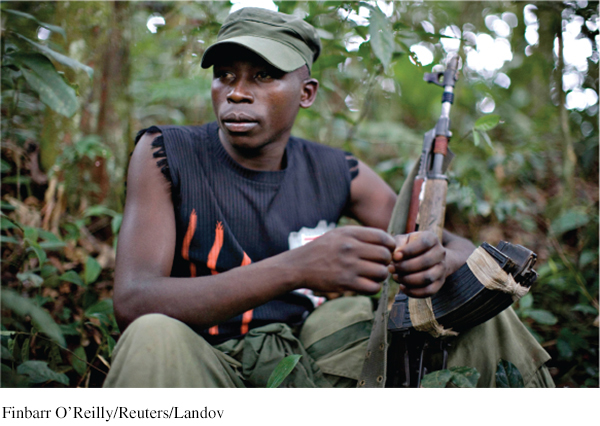
Promoting Peace
How can we change perceptions and make peace? Can contact and cooperation transform the anger and fear fed by prejudice and conflict into peace-
CONTACT Does it help to put two conflicting parties into close contact? It depends. Negative contact increases disliking (Barlow et al., 2012). But positive contact—
With cross-
racial contact, South African’s interracial attitudes have moved “into closer alignment” (Dixon et al., 2007; Finchilescu & Tredoux, 2010). Heterosexuals’ attitudes toward gay people are influenced not only by what they know but also by whom they know (Collier et al., 2012; Smith et al., 2009b). In surveys, the reason people most often give for becoming more supportive of same-
sex marriage is “having friends, family, or acquaintances who are gay or lesbian” (Pew, 2013). Page 343Even indirect contact with an outgroup member (via reading a story or through a friend who has an outgroup friend) has reduced prejudice (Cameron & Rutland, 2006; Pettigrew et al., 2007).
“You cannot shake hands with a clenched fist.”
Indira Gandhi, 1971

However, contact is not always enough. In many schools, ethnic groups segregate themselves in lunchrooms and on school grounds (Alexander & Tredoux, 2010; Clack et al., 2005; Schofield, 1986). People in each group often think they would welcome more contact with the other group, but they assume the other group does not share their interest (Richeson & Shelton, 2007). When these mirror-
COOPERATION To see if enemies could overcome their differences, researcher Muzafer Sherif (1966) manufactured a conflict. He separated 22 boys into two separate camp areas. Then he had the two groups compete for prizes in a series of activities. Before long, each group became intensely proud of itself and hostile to the other group’s “sneaky,” “smart-
superordinate goals shared goals that override differences among people and require their cooperation.
Sherif accomplished this reconciliation by giving them superordinate goals—
A shared predicament can have a powerfully unifying effect for other groups as well. Children and youth exposed to war, and minority group members facing rejection or discrimination, likewise develop strong ingroup identification (Bauer et al., 2014; Ramos et al., 2012).
At such times, cooperation can lead people to define a new, inclusive group that dissolves their former subgroups (Dovidio & Gaertner, 1999). If this were a social psychology experiment, you might seat members of two groups not on opposite sides, but alternately around a table. Give them a new, shared name. Have them work together. Then watch “us” and “them” become “we.” After 9/11, one 18-
If superordinate goals and shared threats help bring rival groups together, might this principle bring people together in multicultural schools? Could interracial friendships replace competitive classroom situations with cooperative ones? Could cooperative learning maintain or even enhance student achievement? Experiments with teens from 11 countries confirm that, in each case, the answer is Yes (Roseth et al., 2008). In the classroom as in the sports arena, members of interracial groups who work together on projects typically come to feel friendly toward one another. Knowing this, thousands of teachers have made interracial cooperative learning part of their classroom experience.
The power of cooperative activity to make friends of former enemies has led psychologists to urge increased international exchange and cooperation. Some experiments have found that simply imagining the shared threat of climate change reduces international hostilities (Pyszczynski et al., 2012). From Brazilian tribes to European countries, formerly conflicting groups have managed to build interconnections, interdependence, and a shared social identity as they seek common goals (Fry, 2012). Let us then engage in mutually beneficial trade, working together to protect our common destiny on this fragile planet and becoming more aware that our hopes and fears are shared. By taking such steps, we can change misperceptions that drive us apart and instead join together in a common cause based on common interests. As working toward shared goals reminds us, we are more alike than different.
Retrieve + Remember
Question 11.19
•Why do sports fans tend to feel a sense of satisfaction when their archrival team loses? Why do such feelings, in other settings, make conflict resolution more challenging?
ANSWER: Sports fans may feel a part of an ingroup that sets itself apart from an outgroup (fans of the archrival team). Ingroup bias tends to develop, leading to prejudice and the view that the outgroup “deserves” misfortune. So, the archrival team’s loss may seem justified. In conflicts, this kind of thinking is problematic, especially when each side in the conflict develops mirror-
Question 11.20
•What are two ways to reconcile conflicts and promote peace?
ANSWER: Peacemakers should encourage equal-